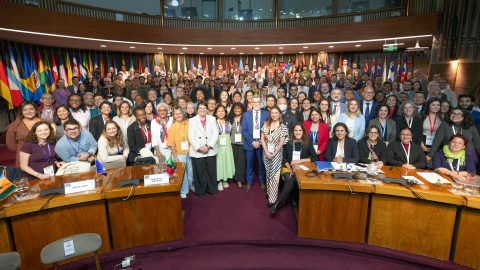Press Release
The number of migrants in this region rose from 21 million people in 2000 to almost 25 million in 2005, accounting for 13% of the world total. This figure reveals the need to put forward measures for the governance of international migration from a Latin American perspective, facilitating mobility, positive externalities, and protecting the human rights of all migrants, ECLAC argues.
The document, "International Migration, Human Rights and Development in Latin America and the Caribbean" was presented to government delegates meeting at ECLAC's Thirty-first Session in Montevideo, this 20-24 March. The meeting is offering orientation to deal with the challenges and opportunities for development posed by migration, from the perspective of the human rights of migrants and their families.
Mexico, the Caribbean Community and Colombia have the most emigrants, more than a million people in each case. Another nine countries have over 500,000 (Argentina, Brazil, Cuba, Ecuador, El Salvador, Guatemala, Haiti, Peru and The Dominican Republic) each. Several Caribbean countries have over 20% of their population abroad, while in Latin America the highest percentages affect Cuba (8.7%), El Salvador (14.5%), Mexico (9.4%), Nicaragua (9.6%), the Dominican Republic (9.3%) and Uruguay (8.3%).
The United States remains the favourite destination. Toward 2004, there were 18 million migrants from the region and along with their descendents born there they are already the country's largest ethnic minority. Their characteristics include the strong links they maintain with their countries of origin. Almost half of the migrants from Latin Americans and the Caribbean are there without proper documentation.
The ECLAC study also found that migration destinations had expanded and diversified. Since the 1990s, the number of Latin Americans heading to Europe (especially Spain), Japan and Canada has risen and is estimated at 3 million people. Spain is the second most popular destination for the region's migrants, with 1.2 million people in 2004.
Argentina, Costa Rica and Venezuela remain the main destinations of migration within the region, although there are several countries that now combine their condition as receivers and senders, transition points along the way or for those returning (several Caribbean islands, Mexico, Central America and some within the Southern Cone). These migrants add up to 3 million people who move between neighbouring countries or those that are relatively close to each other. This coincides with initiatives to facilitate mobility within Caricom, Mercosur and the Andean Community of Nations.
Gender, The Brain Drain and Remittances
Today, half the region's international migrants are women, who often travel alone in search of jobs and end up working as domestic labour.
Skilled migration is causing a brain drain in countries of origin and potential benefits provided professionals circulate and then return do not seemed to have materialized. Nonetheless, several countries have created links with emigrant communities and supported scientific networks associated with these groups. Emigration of professionals, especially nurses and teachers, from countries with smaller economies are particularly worrisome. The most populated countries are also experiencing significant losses of specialists and the constant flow is threatening the critical mass of knowledge.
Another innovative feature of migration is the enormous growth in remittances, which have become a major source of external financing for the region. Mexico, Brazil and Colombia receive more than 60% of the region's remittances and 20% is captured by Guatemala, El Salvador and the Dominican Republic.
Remittances reflect the link with migrant workers and their contribution to domestic economies pose a challenge to public policies. In countries such as Haiti, Nicaragua and Honduras they represent 24%, 11% and 10% of GDP, respectively, and in the larger economies, such as El Salvador and the Dominican Republic, 14% and 10%. Their use, measurement, transfer costs, productive potential are the subject of considerable debate. A recent study by ECLAC found that their impact in terms of the overall poverty of the population is not very significant, although for the households receiving these funds they are a strategic income.
Along with escaping from unemployment and the lack of opportunities, international migration involves growing risks and vulnerability. The human rights of many migrants, whether during their journeys, their integration into destination societies or a repatriation process, tend to be violated in alarming ways, ECLAC points out.
Today, Latin America and the Caribbean have accumulated significant experience in terms of migration governance, which can be useful to adopting joint positions and promoting best practices at the United Nations High-Level Dialogue on International Migration and Development, planned for this year.
Fact Sheet: Challenges and Opportunities for Migration Governance


